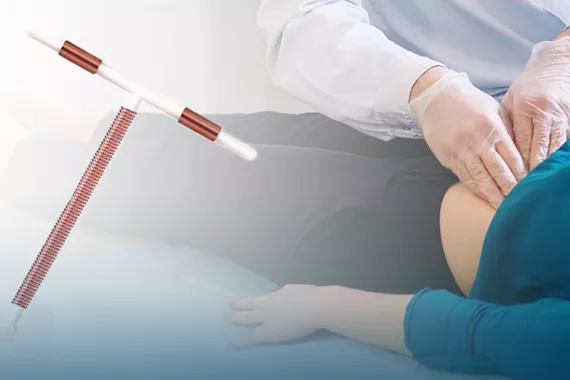
Case Overview
Bleeding or spotting is common after IUD removal. You might experience light spotting or even a heavier flow for a few days, whether you have a hormonal IUD such as the Mirena®, or a copper IUD like Paragard. While initial spotting is normal, heavy or abnormal bleeding could indicate a serious issue.
Key takeaways about bleeding after IUD removal
- Heavy bleeding after IUD removal can indicate a severe problem.
- If a Paragard IUD breaks during removal, heavy vaginal bleeding and painful cramps may occur.
- People are filing Paragard lawsuits to obtain compensation for severe pain, heavy bleeding and the need for additional medical interventions after IUD removal.
What happens during the IUD removal process?
A qualified medical professional will remove any type of IUD at a doctor’s office. Although removal can be done at any time, it is easier to do during menstruation when the cervix is slightly open. Some physicians recommend abstaining from sex for seven days before removal to prevent pregnancy if the IUD will not be replaced.
During removal, the doctor grasps the threads of the IUD with ring forceps to remove it. The arms of the IUD will usually collapse upward as the device slips out. Some light bleeding or mild cramping may happen during the procedure.
Taking a painkiller before IUD removal will help reduce discomfort. Antibiotics or other treatments might be prescribed if the IUD needs to be removed because of an infection. If the IUD doesn’t come out with a light pull, the doctor will need to remove it some other way:
- Forceps: If the IUD is lodged in the uterine wall, the doctor might use medication to widen the cervix and pull the device out with an instrument, like forceps.
- Hysteroscopy: A hysteroscopy may be required if the IUD is attached to the uterine wall. During a hysteroscopy, a doctor widens the cervix and inserts a hysteroscope to enable small instruments to fit inside the uterus. The procedure could take a few minutes or up to an hour.
- Ultrasound-guided removal: This is a less invasive and cost-effective way to remove an IUD that can’t be removed with forceps. Ultrasound-guided removal can be performed in an outpatient setting.
A doctor might use imaging to determine if the IUD has perforated or become embedded in the uterus, especially if it cannot be removed with a slight tug. If a Paragard IUD breaks or becomes embedded in the uterine wall, removal can be difficult.
What to expect after IUD removal
You might experience cramps, light bleeding or spotting after IUD removal. It is common for these side effects to continue for a few days or weeks. Over-the-counter pain relievers like acetaminophen or ibuprofen can help relieve the pain.
Normal activities can be resumed after IUD removal. However, doctors recommend avoiding strenuous exercise and sexual activity.
Side effects after IUD removal
Individuals may experience some side effects after IUD removal. These symptoms may be considered normal or serious.
Normal IUD removal symptoms
Normal IUD removal symptoms include cramping and light spotting. According to the Paragard label, removal can lead to:
- Fainting
- Pain and/or bleeding
- Seizures
- Slower-than-normal heart rates
These symptoms are more common in people susceptible to these issues.
Serious IUD removal symptoms
If the IUD perforates the uterus near critical blood vessels before removal, this may lead to bleeding and issues with blood flow to vital organs. If the IUD leaves the uterus and moves into the abdominal cavity, it can cause inflammatory reactions and bowel adhesions or perforations.
After IUD removal, issues such as infection can also occur. You should contact your physician if you have any of the following IUD removal symptoms:
- Bad-smelling vaginal discharge: Itching, redness, irritation and an unpleasant-smelling discharge could all be signs of an infection.
- Fever: A fever above 101 degrees Fahrenheit could indicate a serious problem.
- Heavy bleeding: Soaking through one or more tampons or pads every hour for several hours, bleeding that requires you to wear more than one pad at once or bleeding that includes clots the size of a quarter or larger is not normal.
- IUD removal pain: IUD removal can be uncomfortable, particularly if your IUD has moved or shifted. You could experience cramping after IUD removal as your body adjusts.
- No periods: Call your doctor if your period does not return six months after IUD removal. They can check for hormonal problems or other underlying reasons you are not menstruating.
- Severe pain: Pain that cannot be controlled using over-the-counter medications like Tylenol and Motrin.
People who have experienced severe complications from IUD removal may be eligible to pursue legal action.
Heavy bleeding after IUD removal
Vaginal bleeding lasting several hours to several days after the IUD removal is common. However, patients should seek medical attention if they experience any of the following:
- Bleeding that does not resolve on its own
- Extended heavy bleeding
- Light-headedness due to blood loss
- Severe pain
- Signs of infection (bad-smelling discharge, fever, or painful sex)
When IUD removal symptoms can lead to a Paragard lawsuit
Some patients have filed Paragard IUD lawsuits after extreme reactions to IUD removal. These women and their doctors relied on Teva Pharmaceutical Industries and The Cooper Companies (the makers and distributors of Paragard) to provide reliable information about the safety of Paragard use.
However, the companies did not address the IUD’s safety issues, even after the U.S. Food and Drug Administration (FDA) received over 2,000 adverse event reports about Paragard harm. These reports described a defect causing the IUD to break inside the body, leading to serious health risks.
Even though they were aware of this defect, Paragard’s makers did not update the device’s warning label until 2019. Before that, the label didn’t warn consumers that Paragard tended to break during routine and non-surgical removal procedures. The label also failed to mention the frequency of breakages. In 2019, the companies added this information to the label.
Despite this knowledge, the companies overstated Paragard’s safety and downplayed the IUD’s risks. They marketed Paragard as the “safest form of long-lasting, non-surgical, non-permanent birth control.” The marketing materials say a healthcare provider can remove Paragard during a routine office visit in a few minutes. They imply that removal is easy and safe without risk of complications.
However, Paragard can cause serious harm if it breaks in utero or during removal. Numerous consumers have required additional medical intervention to retrieve broken pieces of Paragard from their bodies via surgery or hysterectomy, leading to infertility.
If you are experiencing heavy bleeding or severe pain due to Paragard removal, seek medical attention immediately. If you were forced to undergo additional medical procedures, including a hysterectomy, because of complications during Paragard removal, you might be eligible to file a lawsuit. A birth control defect lawyer can help you determine your eligibility for this type of claim.
Frequently asked questions about bleeding after IUD removal
Why am I bleeding after IUD removal?
Light bleeding lasting a few days or weeks after IUD removal is normal. However, heavy bleeding or severe pain could indicate a serious problem and should be checked by a doctor.
Is it normal to have spotting after IUD removal?
Yes, it is normal to have light spotting after an IUD is removed. However, it’s important to monitor this bleeding to ensure it doesn’t become heavier.
When is bleeding after IUD removal serious?
Bleeding after IUD removal may be serious if you
- Are going through many tampons or pads over several hours
- Discover blood clots the size of a quarter or larger
- Need to wear more than one pad at a time
These are abnormal reactions that could signal a more serious issue. Serious Paragard IUD complications may make an individual eligible for a birth control lawsuit.
Our birth control litigation experience
The attorneys at Motley Rice have extensive experience representing people alleging harm by defective medical devices, including:
- Acting as court-appointed lead counsel for coordinated cases involving the permanent birth control device Essure®
- Acting as court-appointed co-lead counsel for the Mirena IUD multidistrict litigation (MDL)
- Serving on the Plaintiffs’ Steering Committee (PSC) for NuvaRing® MDL
Medical attorney Fidelma Fitzpatrick is a member of the plaintiffs’ executive committee (PEC) of the Paragard MDL. She has also served as court-appointed lead counsel and a member of the PEC for more than 32,000 Essure cases consolidated in California state court. She also serves as a court-appointed co-lead in the federal hair relaxer MDL that is focused on women with reproductive cancers.
Read more on our birth control litigation experience.
Do not stop taking a prescribed medication without first consulting with your doctor. Discontinuing a prescribed medication without your doctor’s advice can result in injury or death. Paragard, Mirena, NuvaRing, Tylenol, and Motrin remain approved by the U.S. Food and Drug Administration.
Key takeaways
What happens during the IUD removal process?
What to expect after IUD removal
Side effects after IUD removal
Heavy bleeding after IUD removal
When IUD removal symptoms can lead to a Paragard lawsuit
Frequently asked questions about bleeding after IUD removal
Our birth control litigation experience
- Sources
- FPA Women’s Health. Topic Tuesday: Vaginal odor.
- GoodRx Health. IUD Removal: Here’s What to Expect.
- Healthline. How is an Intrauterine Device (IUD) removed?
- Medical News Today. Everything you need to know about IUD removal.
- Nationwide Children’s. Intrauterine Device (IUD) Removal.
- Rosh Maternal & Fetal Medicine. What To Expect After IUD Removal.
- UPMC Health Beat. How Long Does It Take for Periods to Regulate After IUD Removal?
- U.S. Food and Drug Administration. HIGHLIGHTS OF PRESCRIBING INFORMATION. These highlights do not include all the information needed to use PARAGARD® safely and effectively. See full prescribing information for PARAGARD.
- Verma U, Astudillo-Davalos F, Gerkowicz S. Contraception Journal. Safe and cost-effective ultrasound guided removal of retained intrauterine device: our experience. Volume 92, Issue 1, pp 77-80. July 2015.
- Web MD. IUD Removal: What to Expect.
- Web MD. Signs Your IUD Is Out of Place.
Start Your Motley Rice Consultation in Simple Steps
Submit Information
Call us or fill out our online form with the details of your potential case.
Case Review
Our team reviews your information to assess your potential case.
Case Consultation
Talk with us about next steps.

